典范英语拼读教程3 Lesson5
- 格式:ppt
- 大小:9.59 MB
- 文档页数:21
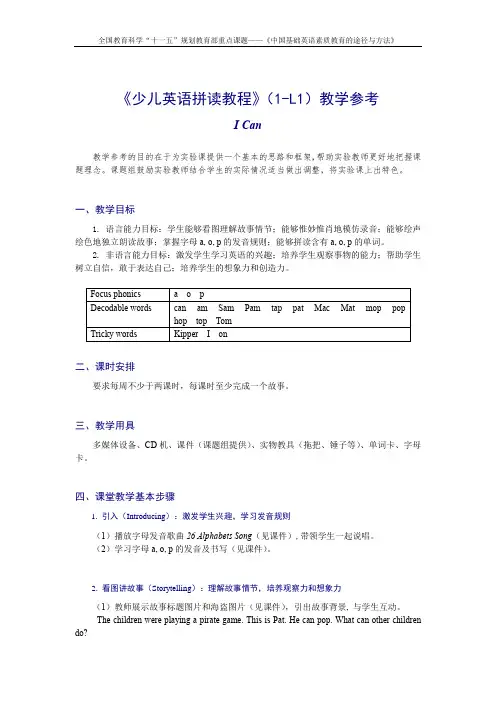
《少儿英语拼读教程》(1-L1)教学参考I Can教学参考的目的在于为实验课提供一个基本的思路和框架,帮助实验教师更好地把握课题理念。
课题组鼓励实验教师结合学生的实际情况适当做出调整,将实验课上出特色。
一、教学目标1. 语言能力目标:学生能够看图理解故事情节;能够惟妙惟肖地模仿录音;能够绘声绘色地独立朗读故事;掌握字母a, o, p的发音规则;能够拼读含有a, o, p的单词。
2. 非语言能力目标:激发学生学习英语的兴趣;培养学生观察事物的能力;帮助学生树立自信,敢于表达自己;培养学生的想象力和创造力。
二、课时安排要求每周不少于两课时,每课时至少完成一个故事。
三、教学用具多媒体设备、CD机、课件(课题组提供)、实物教具(拖把、锤子等)、单词卡、字母卡。
四、课堂教学基本步骤1. 引入(Introducing):激发学生兴趣,学习发音规则(1)播放字母发音歌曲26 Alphabets Song(见课件),带领学生一起说唱。
(2)学习字母a, o, p的发音及书写(见课件)。
2. 看图讲故事(Storytelling):理解故事情节,培养观察力和想象力(1)教师展示故事标题图片和海盗图片(见课件),引出故事背景, 与学生互动。
The children were playing a pirate game. This is Pat. He can pop. What can other children do?(2)利用课件逐幅播放故事图片,并用丰富的表情、生动的英文和适当的肢体语言给学生绘声绘色地讲故事,感受孩子们扮演海盗的乐趣。
(Picture 1) Look at Kipper. “I am Kipper. I mop, mop, mop,” said Kipper. Can you mop? (请学生演示)(Picture 2) Look at Pam. “I am Pam. I tap, tap, tap,” said Pam.(请学生演示)(Picture 3) Look! Oh, this is Mat the pirate. “I am Mat. I pat, pat, pat,” said Mat.(请学生演示)(Picture 4) Who’s this? This is Pat. She was making pops. “I am Pat. I pop, pop, pop,” said Pat. Did Floppy like pops?(Picture 5) “I am Tom. I mop, mop, mop.” said Tom.(Picture 6) Here is the pirate Mac. “I am Mac. I hop, hop, hop,” said Mac.(请学生演示)(Picture 7) Who is on top? Sam is on top. “I am Sam. I am on top,” said Sam. (请学生演示)(Picture 8) Can you name all the pirates? Kipper, Pam, Mat, Pat, Tom, Mac and Sam.教师在讲故事过程中要注意启发学生思考,每次提问之后稍作停顿,不要急于说出答案,先观察学生的反应,如学生仍回答困难,再进一步给出提示引导学生作答。

《典范英语》(3a-L22)教学参考A Big Bunch of Flowers教学参考的目的在于为实验课提供一个基本的思路和框架,帮助实验教师更好地把握课题理念。
课题组鼓励实验教师结合学生的实际情况适当做出调整,将实验课上出特色。
一、教学目标1. 语言能力目标:学生能够读懂故事情节;惟妙惟肖地模仿录音;绘声绘色地独立朗读故事;能根据提示复述故事;能流畅地表演故事;掌握字母组合“or”的拼读规律;能改写故事。
2. 非语言能力目标:通过让学生观察Dad买花的过程培养学生的观察力;体会Dad的心情变化;鼓励学生大胆表达自己的经历,培养学生的自信和勇气。
二、课时安排要求每周不少于两课时,每课时至少完成一个故事。
三、教师要求1. 教师课前须熟读故事,了解故事内容。
2. 对于较难的单词,教师可板书,并配合动作和表情帮助学生理解。
3. 全英文授课。
四、教学用具多媒体设备、CD机、课件(课题组提供)、道具(一束花、空白纸条)、单词卡(enormous)。
五、课堂教学基本步骤1. 导入(Lead-in):谈论自己送花的经历,引入故事情景通过展示实物,讨论自己曾经送花的经历,为看图讲故事做好铺垫。
(1)教师拿出一花束,并与学生互动:Look here. What’s this?(展示一朵花)It is a flower.Look! What’s this?(展示一大束花)It is a bunch of flowers.(板书故事标题)Have you bought a bunch of flowers?When did you buy it?Who was it for?引导学生使用“I bought a bunch of flowers for …”句型来回答。
(2)学生回答后,自然过渡到讲故事环节:Dad bought a big bunch of flowers. Who was it for? Why did he buy it? Le t’s learn the story A Big Bunch of Flowers.2. 看图讲故事(Storytelling):理解故事情节,观察故事中Dad为何买了两束花教师利用课件逐幅播放故事图片,并用丰富的表情、生动的英文和适当的肢体语言给学生绘声绘色地讲故事,让学生观察Dad买了几束花以及原因。
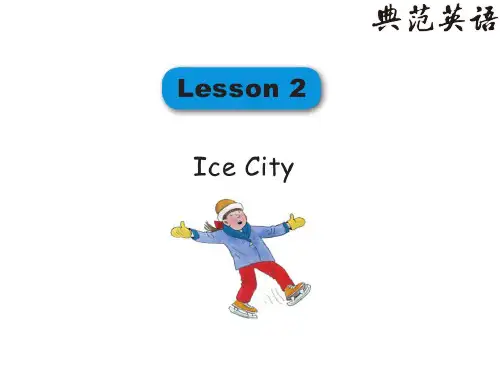
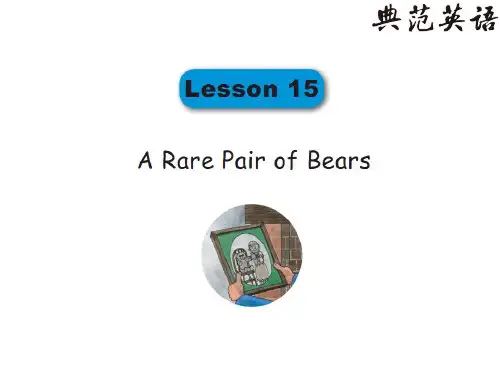

Lesson 16 Red Noses○1 Mum has a posh dress on.○2 She was going out.Dad has lots of jobs to do.○3 Mum went off.○4 Chip got the paints out.○5 The red paint pot fell over.○6 Red paint ran on to Floppy.○7“ Floppy has a red nose ”, said chip.○8 Dad put a dab of red paint on Chip ' s nose. ○9“ Kipper has a red nose ” said dad.○10 Dad went to dab paint on Biff 's nose.○11“ Oh no! You will not get me ”, said Biff.○12 Dad ran to get her.Dad ran and ran.○13“I will get you ”, said dad.○14 Oh, no! Splat!○15 Mum had a red nose. Dad had a red face.Lesson 17 The Ball Pit○1 Kipper and Anna went in the ball pit. ○2“ I am a batman, ” said Kipper.○3 He fell into the ball pit.○4 Then Anna fell into the pit.○5 But her glasses fell off.○6“Oh, no!, ” said Anna, “ my glasses! ” “ I can not find them, ”7 Anna was upset. “ Get out of the ball pit, ” said Kipper.8 They all got out.○9“ I can not find them, ”said the man.○10 “ We must get the ballsout, ” the man said.○11 They put the balls in a big net.○12 “ Hooray! My glasses! ” said Anna. “A lot of things in the ball pit Kipper.○13“A lot of odd things, ” said Anna.Lesson 18 Out!“ Chip can go, ” said Wilma.Chip went, but his foot was out.“ Chip is out, ” "sa“id BH i fsf, foot went out. ”“ It did not, ” said Chip.“ Yes, it did, ” said Biff.Biff and Chip fell out.Wilf ran to get Mrs. May.“ We can not see the grid , ” said Wilma.“ I see, ” said Mrs. May.Mrs. May painted the grid, “ You can paint it, ” she said.Wilf put in the sun. Biff painted a cat. Chip put in a dog. Wilma painted a bug. The grid was painted.Mrs. May had a go. “Mrs. May 's foo,t wseaindt Bouiftf.Bad luck, said Wilma.Lesson 21 The New Gingerbread ManLee and Lin made a gingerbread man.“ Put him in the oven, ” said Lee.Lin got a book. “ It is about a gingerbread man, ” said Lee.“ He is running off, ” said Lin, “ Run, run, get him. ”“ Let ' s check the oven, ” said Grandpa Chen. He got the gingerbread man. “ He is hot, ” said Grandpa, “ I will put him on the rack ”.“ Will he run off? ” said Lin.The gingerbread man did not run off. But Button jumped up.Then Button ran off.“ Run, run ” said Lee.“ Get him ” said Lin.Lee and Lin made a new gingerbread man.Lesson 22 A Big Bunch of FlowersDad got flowers for mum. He had a big bunch.“ Flowers for mum, ” he said. He put the flowers on the back. The flowers fell off. Oh, no. Dad was upset. He has lost the flowers. Wilma saw the flowers. “ Lost flowers ” said her mum. She put them on a bin.Dad was in a rush. He went back to the flower shop.He got a big bunch of flowers.Dad saw his lost flowers. “ Well, well, ” he said.“ Flowers for mum, ” said Dad.“ Make them up, ” said Chip. “ Then it will be a big bunch.“ It ' s an abnoral bunch, ” said mum , ” Thank you! ”○1 It was fun on the beach.○2 Wilma had a ball. Dad put up a net.○3“ This is fun ” said Chip. Floppy ran to get the ball.○4“ No, Floppy, ” said mum, “ it will pop if you get it. ”○5 There was a big gust of wind.○6 It took the ball off. “ Catch it! ” said Dad. Dad ran to get it ,but it we into the sea.○7“ We can not get it ” said Dad.○8 A man on a jet ski got the ball.○9“ Can you catch it? ” said the man.“Yes, I can catch it, ” said Dad, “ Thank you!○10 Dad did not get the ball. Oh, no! Floppy did.○11” It is a Floppy 's ball ” said Wilma.1.Kipper was having fun with Lee.2 .They had a drink.3 ."HIC!" said Kipper. He had hiccups.4 ."Quick! Get a cup of water," said Lee.5 ."Did that get rid of the hiccups?" said Lee.6 ."HIC!" said Kipper. "HIC!"7 ."Drink it like this," said Biff.8."Did that get rid of them?" said Biff. "HIC!" said Kipper."Try hopping and patting your tum!" said Chip.9 ."Has that got rid of them?" said Chip.10."HIC!" said Kipper.11."A shock will get rid of it," said Biff. 12."Shhh..." said Biff. Then...13."Boom!"14."You did it!" said Kipper. " You got rid of my hiccups!" 15."HIC!" said Grandpa Chen. "HIC!"Lesson 25 Floppy and the Puppets1. The children had some puppets.2. "This puppet is Dad," said Biff."And this puppet is Mum." "This is the dog," saidKipper .3. Floppy was not happy. He did not like the puppets.4. Floppy barked and barked.5. "The puppets upset him," said Mum.6. Floppy got into his basket. He fell asleep and had a dream.7. Oh no! Mum and Dad were puppets. So were the children8. The Biff puppet gave Floppy bits of wood to eat.9. Then the children played with the dog puppet.10. Floppy was not happy.11. Floppy sat up. It had been a bad dream.12. Floppy was happy to wake up.Lesson 26 Monkeys on the Cars1. Mum and Dad took the children to the safari park.2. “ Stop in the car, ” said the man ."Or a lion will get you ," said Dad.3. They saw the zebras. "A zebra crossing ," said Biff.4. They saw the elephants. "Look at the baby elephant," said Kipper.5. They saw the lions. "I can see lion cub," said Chip.6. The monkeys jumped on the car . They pulled at the wipers.7. The monkeys pulled and pulled.8. They pulled the wipers off. "Oh no," said Dad9. "You bad monkeys !" said Biff.10. "I see you had monkeys on the car ," said the man.11. "Yes! And monkeys in the car ," said Dad.Lesson 27 Dragons1. The children went to the woods with Mrs may.2. "You can make wigwams," said Mrs May. The children went to get sticks.3. "Look at that!" said Biff. "It;s a dragon!" said Wilf.4. "Did you see the green dragon?" said Biff. " Don't be silly!" said Chip.5. "Look," said Wilf. "Did you see that?" "It's a red dragon!" said Biff.6. "Did you see the dragons?" said Wilf. "Don't be silly!" said Chip7. "See!" said Biff. "We did see dragons." "They are in a play. We can go andsee it ," said Mrs May.8. So the children went to see the play. The dragons sang a song.9. Then the dragons did a jig. "The dragons are fun," saidChip.Lesson 28 The Enormous Picture1. The minibus broke down.2. "It will cost a lot to fix it," said Mrs May. "We need lots of money," said Chip.3. "We can paint an enormous picture," said Chip."We can all paint a bit," hesaid. "We can," said Mrs May.4. Mrs May made a copy of the picture. She cut it into squares.5. "Paint a big picture of your bit," said Mrs May.6. Biff had to paint yellow petals.7. Chip just had to paint a yellow square.8. Mrs May took all the children's squares.9. She made an enormous picture.10. People came to see the enormous picture. It made a lot of money.11. The minibus was mended. "The enormous picture did a good job," said MrsMay.12. "That is not as good as our enormous picture!" said Chip.Lesson 29 Gran and the Go-kartsGran took the children to a go-kart track."Can I have that go-kart?" said Chip."Yes. Put on this kit, "said a man.Biff, Chip and Wilf began to race. Wilf went fast. Biff and Chip went fast too. But Wilf won the race!"That was such fun!" said the children. "You can go again," saidGran, “And I will race you all. ”The children went fast, Gran went fast, tooGran went faster and faster , she went passed Wilf.But Gran went too fast.Oh no!“Bad luck, Gran. ” said Biff. “ I will win next time ” said Gran.Lesson 30 Helicopter RescueThe children saw a helicopter . “It 's a rescue helicopter , “said Chip, “You can go in and look, ” said the man.The children went into the helicopter . They saw the cooper pet “W e pull people up with this winch. , ” said the man.Rescue, rescue, rescue. ” It 's a call out, ” said the man, ”We must rescue a boat. The helicopter took off.“ Look, that is the boat, ” said mum.The helicopter went to the boat. It had hit a rock.The boy was hurt. They took him up on the winch.“T hat was a real rescue, “ said Chip.。
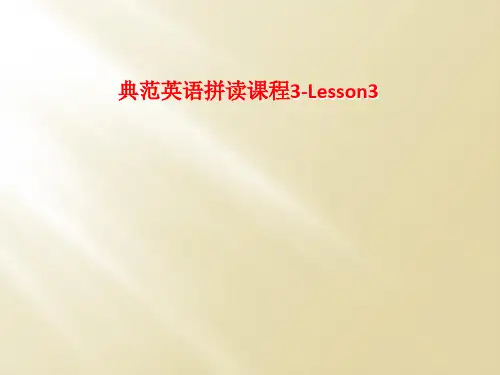

典范英语《典范英语》原名《牛津阅读树》(Oxford Reading Tree),是英国牛津大学出版社出版的一套家喻户晓的英语教材。
英国80%的学校用它教学生学习母语,全球133个国家也在使用这套教材。
《典范英语》(1-5)从中精选出261个最有趣的故事,经过精心编辑而成,供我国小学生学习英语之用。
一套英国孩子学习母语的教材拿来给中国孩子用,这样做合适吗?我们的回答是:合适。
而且我们认为,只有学这样的英语,孩子们才会学得开心,学得轻松,学得地道,学得有效。
儿童学习语言,选用什么样的语言材料作为教材,关乎孩子语言素质的发展。
无论母语教材还是外语教材,首先要保证语言纯正地道。
《典范英语》(1-5)来自英国本土,语言鲜活纯正,原汁原味,由浅入深,中国孩子完全可以学得来,学了可以享用终生。
在学习语言的关键期,能和英国孩子念一样的英语,我们的孩子是多么幸运!好的儿童语言教材,除了语言纯正地道之外,还要看内容能否吸引孩子。
《典范英语》(1-5)基于孩子的生活体验和心理特点,精心编织了几百个引人入胜的故事,个个生动有趣,人物活灵活现,可爱至极,完全是一片孩子的生活乐园和精神天地。
读这样的故事,学这样的英语,能使孩子们的心智和品格都受益。
反观那些句句符合语法,“有句无文,有文无情”的课文,干瘪乏味,缺乏心智上的启迪,早已倒掉了孩子们的胃口。
有了好的教材就能保证孩子学好英语吗?不完全是。
还要看如何用好这套教材。
首先,要有正确的认识。
研究表明,12岁以前是学习语言的关键期。
孩子学习一门语言,越早接触越好,这对习得地道的口音尤为重要。
经验表明,孩子置身某种语言环境,他会自然习得这种语言,这是孩子的天性。
在中国学英语没有这样的语言环境怎么办?教孩子系统地听、念英国同龄儿童喜欢的故事,就等于给他提供了一个全英语的环境。
听得多了,孩子可以做到用英语“见什么人说什么话”;念得多了,还可以做到“知书达理”。
千万不要低估孩子的语言潜能。
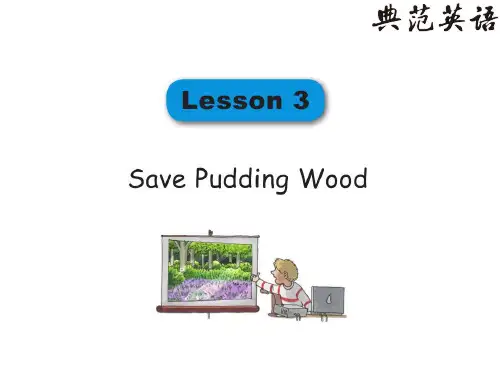
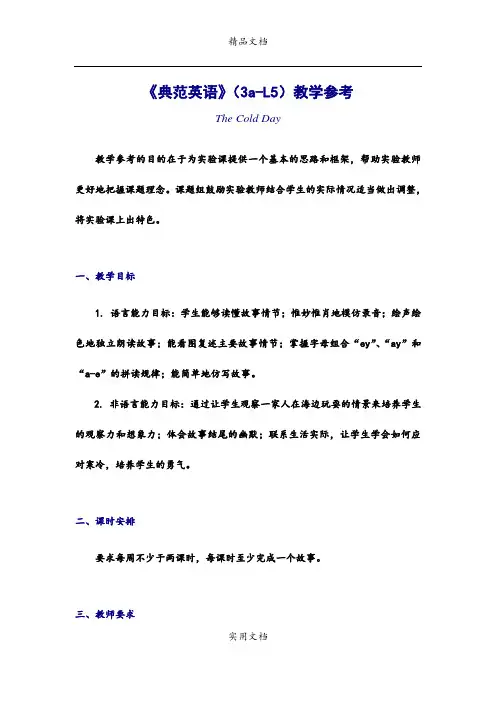
《典范英语》(3a-L5)教学参考The Cold Day教学参考的目的在于为实验课提供一个基本的思路和框架,帮助实验教师更好地把握课题理念。
课题组鼓励实验教师结合学生的实际情况适当做出调整,将实验课上出特色。
一、教学目标1. 语言能力目标:学生能够读懂故事情节;惟妙惟肖地模仿录音;绘声绘色地独立朗读故事;能看图复述主要故事情节;掌握字母组合“ey”、“ay”和“a-e”的拼读规律;能简单地仿写故事。
2. 非语言能力目标:通过让学生观察一家人在海边玩耍的情景来培养学生的观察力和想象力;体会故事结尾的幽默;联系生活实际,让学生学会如何应对寒冷,培养学生的勇气。
二、课时安排要求每周不少于两课时,每课时至少完成一个故事。
三、教师要求1. 教师课前须熟读故事,了解故事内容。
2. 对于较难的单词,教师可板书,并配合动作和表情帮助学生理解。
3. 全英文授课。
四、教学用具多媒体设备、课件(课题组提供)、故事图片(第2、3、4、6、7、9幅图)、单词或短语卡(play in the waves, jog, play cricket, dig in the sand)五、课堂教学基本步骤1. 导入(Lead-in):谈论天气,引入故事情景教师引导学生谈论天气,以及在天冷的时候喜欢做什么,从而引入故事情境。
What’s the weather like? (分别展示热天和冷天两幅图)What do you like to do on hot days/on cold days? (请学生自由回答)Do you like to play in the sea on hot days? (展示夏季海滩游玩的图片)Do you like to go to the seaside on cold days?之后,展示故事第一幅图片,自然过渡到讲故事环节:Look! The children were in the sea.(展示故事第1幅图)Was it a cold day or a hot day? What would happen in the story? Let’s have a look.2. 看图讲故事(Storytelling):理解故事情节,观察一家人在海边玩耍的情景教师利用课件逐幅播放故事图片,并用丰富的表情、生动的英文和适当的肢体语言给学生绘声绘色地讲故事,让学生观察天气以及一家人在海边做了些什么。
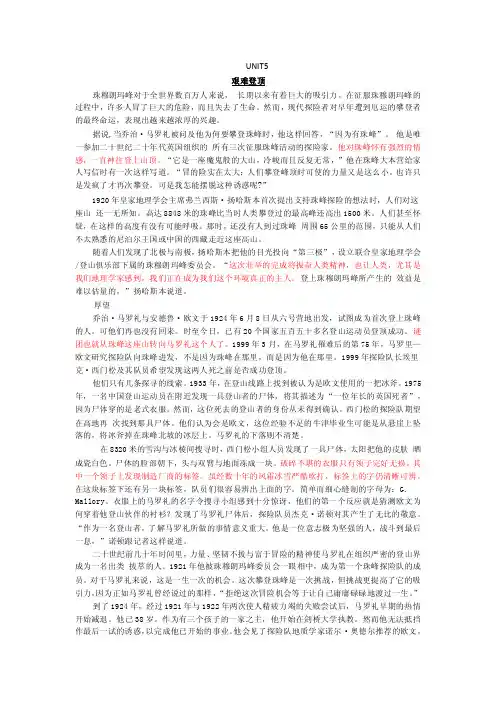
UNIT5艰难登顶珠穆朗玛峰对于全世界数百万人来说,长期以来有着巨大的吸引力。
在征服珠穆朗玛峰的过程中,许多人冒了巨大的危险,而且失去了生命。
然而,现代探险者对早年遭到厄运的攀登者的最终命运,表现出越来越浓厚的兴趣。
据说,当乔治·马罗礼被问及他为何要攀登珠峰时,他这样回答,“因为有珠峰”。
他是唯一参加二十世纪二十年代英国组织的所有三次征服珠峰活动的探险家。
他对珠峰怀有强烈的情感,一直神往登上山顶。
“它是一座魔鬼般的大山,冷峻而且反复无常,”他在珠峰大本营给家人写信时有一次这样写道。
“冒的险实在太大;人们攀登峰顶时可使的力量又是这么小。
也许只是发疯了才再次攀登。
可是我怎能摆脱这种诱惑呢?”1920年皇家地理学会主席弗兰西斯·扬哈斯本首次提出支持珠峰探险的想法时,人们对这座山还一无所知。
高达8848米的珠峰比当时人类攀登过的最高峰还高出1500米。
人们甚至怀疑,在这样的高度有没有可能呼吸。
那时,还没有人到过珠峰周围65公里的范围,只能从人们不太熟悉的尼泊尔王国或中国的西藏走近这座高山。
随着人们发现了北极与南极,扬哈斯本把他的目光投向“第三极”,设立联合皇家地理学会/登山俱乐部下属的珠穆朗玛峰委员会。
“这次壮举的完成将振奋人类精神,也让人类,尤其是我们地理学家感到,我们正在成为我们这个环境真正的主人。
登上珠穆朗玛峰所产生的效益是难以估量的,”扬哈斯本说道。
厚望乔治·马罗礼与安德鲁·欧文于1924年6月8日从六号营地出发,试图成为首次登上珠峰的人。
可他们再也没有回来。
时至今日,已有20个国家五百五十多名登山运动员登顶成功。
谜团也就从珠峰这座山转向马罗礼这个人了。
1999年3月,在马罗礼罹难后的第75年,马罗里—欧文研究探险队向珠峰进发,不是因为珠峰在那里,而是因为他在那里。
1999年探险队长埃里克·西门松及其队员希望发现这两人死之前是否成功登顶。
他们只有几条探寻的线索。
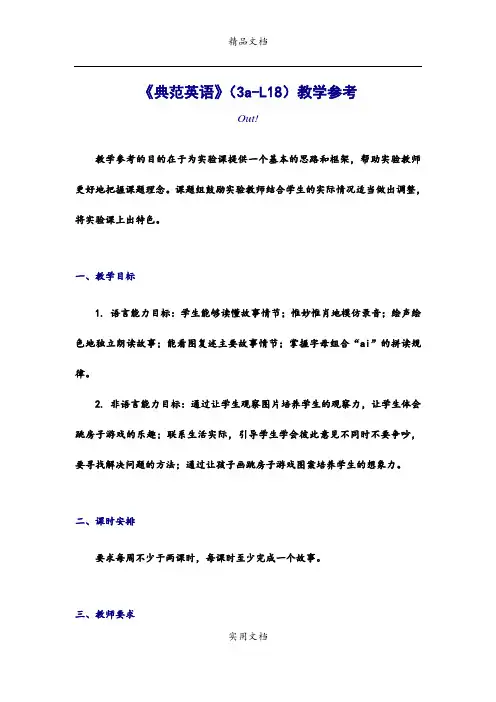
《典范英语》(3a-L18)教学参考Out!教学参考的目的在于为实验课提供一个基本的思路和框架,帮助实验教师更好地把握课题理念。
课题组鼓励实验教师结合学生的实际情况适当做出调整,将实验课上出特色。
一、教学目标1. 语言能力目标:学生能够读懂故事情节;惟妙惟肖地模仿录音;绘声绘色地独立朗读故事;能看图复述主要故事情节;掌握字母组合“ai”的拼读规律。
2. 非语言能力目标:通过让学生观察图片培养学生的观察力,让学生体会跳房子游戏的乐趣;联系生活实际,引导学生学会彼此意见不同时不要争吵,要寻找解决问题的方法;通过让孩子画跳房子游戏图案培养学生的想象力。
二、课时安排要求每周不少于两课时,每课时至少完成一个故事。
三、教师要求1. 教师课前须熟读故事,了解故事内容。
2. 对于较难的单词,教师可板书,并配合动作、表情帮助学生理解。
3. 全英文授课。
四、教学用具多媒体设备、CD机、课件(课题组提供)、故事图片、单词卡片及图片(paint/rain/train/wait/fail/afraid)。
五、课堂教学基本步骤1. 导入(Lead-in):通过玩“跳房子”游戏引入故事情境通过展示图片(见课件)和玩“跳房子”游戏,引出故事情境,为看图讲故事做好铺垫。
I’d like to show you some pictures about a game.It’s called hopscotch.(教师将“hopscotch”板书,引导学生运用拼读规律拼读)Do you like playing hopscotch?Who wants a go? (教师在讲台上画出简单的格子图,示范如何玩,然后请学生参与)之后,自然过渡到看图讲故事环节:Biff was playing hopscotch with her friends. How did they play? Did they have fun? Let’s learn the story.2. 看图讲故事(Storytelling):理解故事情节,体会孩子们心情变化教师利用课件逐幅播放故事图片,并用丰富的表情、生动的英文和适当的肢体语言给学生绘声绘色地讲故事,让学生观察并体会孩子们从一起游戏到吵架到解决问题这一过程的心情变化。
《少儿英语拼读教程》(1-L2)教学参考Cats教学参考的目的在于为实验课提供一个基本的思路和框架,帮助实验教师更好地把握课题理念。
课题组鼓励实验教师结合学生的实际情况适当做出调整,将实验课上出特色。
一、教学目标1. 语言能力目标:学生能够看图理解故事情节;能够惟妙惟肖地模仿录音;能够绘声绘色地独立朗读故事;掌握字母m, t, c的拼读规律;能够拼读含有m, t, c, a, o, p的单词。
2. 非语言能力目标:引导学生感受孩子们表演短剧的快乐;激发学生学习英语的兴趣;培养学生观察事物的能力以及表演能力。
二、课时安排要求每周不少于两课时,每课时至少完成一个故事。
三、教学用具多媒体设备、CD机、课件(课题组提供)、人物图片、人物名字卡片、字母卡。
四、课堂教学基本步骤1. 复习(Review):回顾上一故事,复习字母a, o, p的发音规则(1)展示第一课I Can的最后一幅图片(见课件),带领学生回顾故事人物。
Do you still remember our new friends?Who are they?学生说出人物名字后,教师可展示人物名字卡片并引导学生进行拼读,如S-a-m-Sam.(2)复习字母a, o, p的发音及单词拼读与书写。
教师根据图片进一步提问,请学生回答并尝试写出相应的单词。
What can they do? (Kipper can mop. Pam can tap…)Who can try to write tap/top…?如有需要,教师可提前示范segmenting及书写的过程。
2. 引入(Introducing):激发学生兴趣,学习发音规则(1)播放歌曲Al Can(见课件),带领学生一起说唱,并与学生互动:What can Al do?(2)引入本课主要的发音规则,学习字母m, t, c的发音及书写(见课件)。
3. 看图讲故事(Storytelling):理解故事情节,感受表演的乐趣(1)教师展示故事第3幅图片(见课件),引出故事背景, 与学生互动。